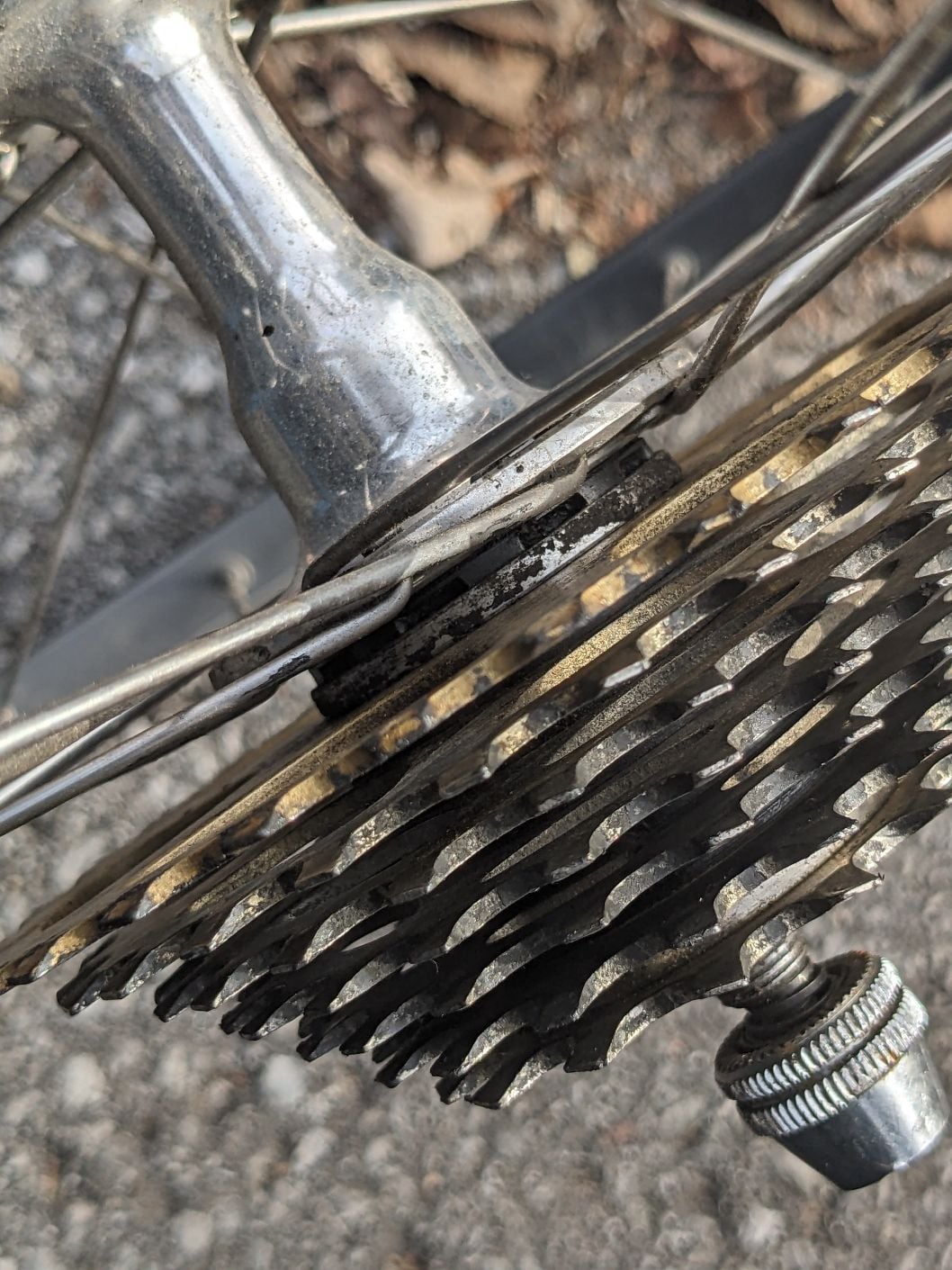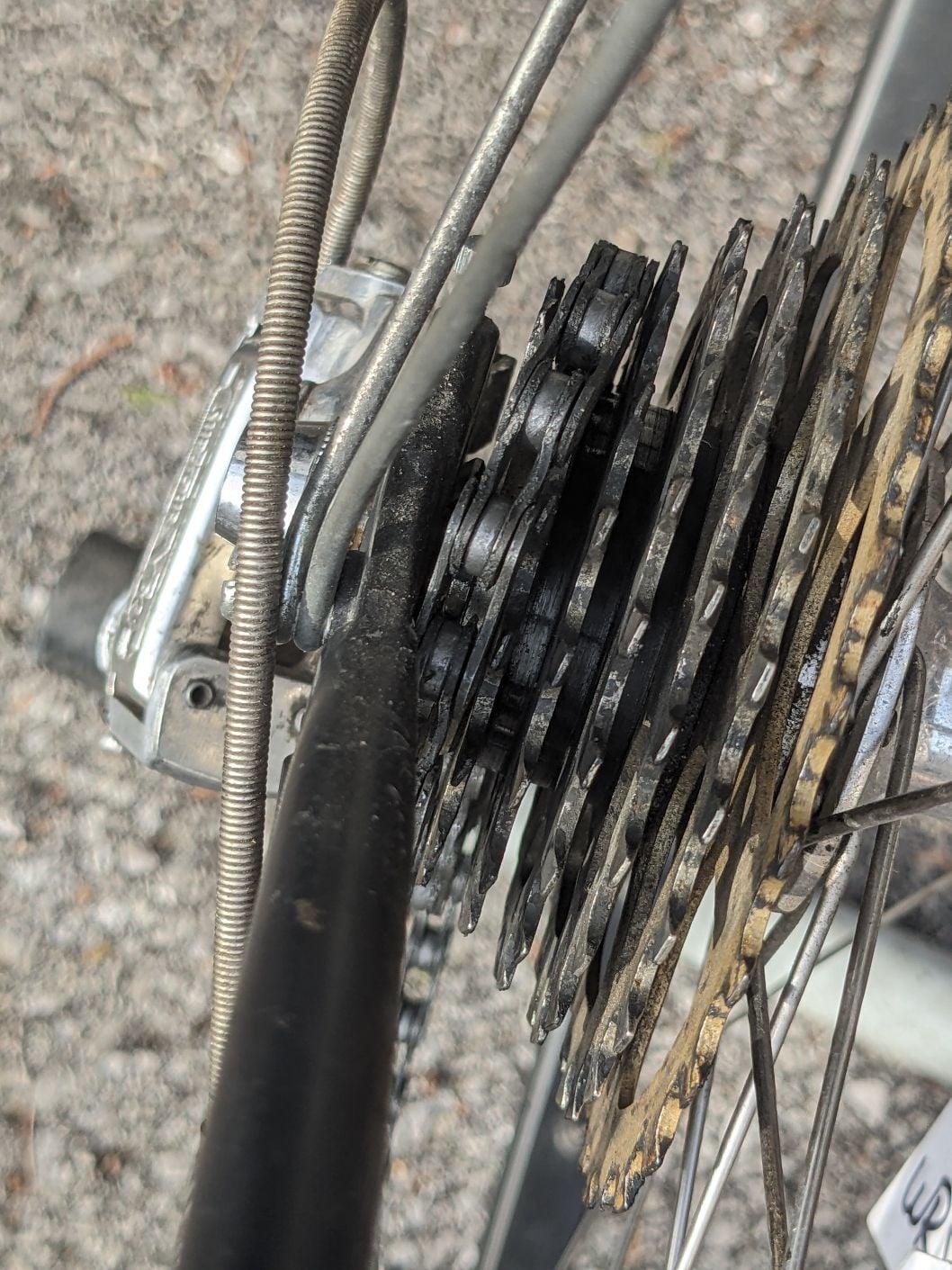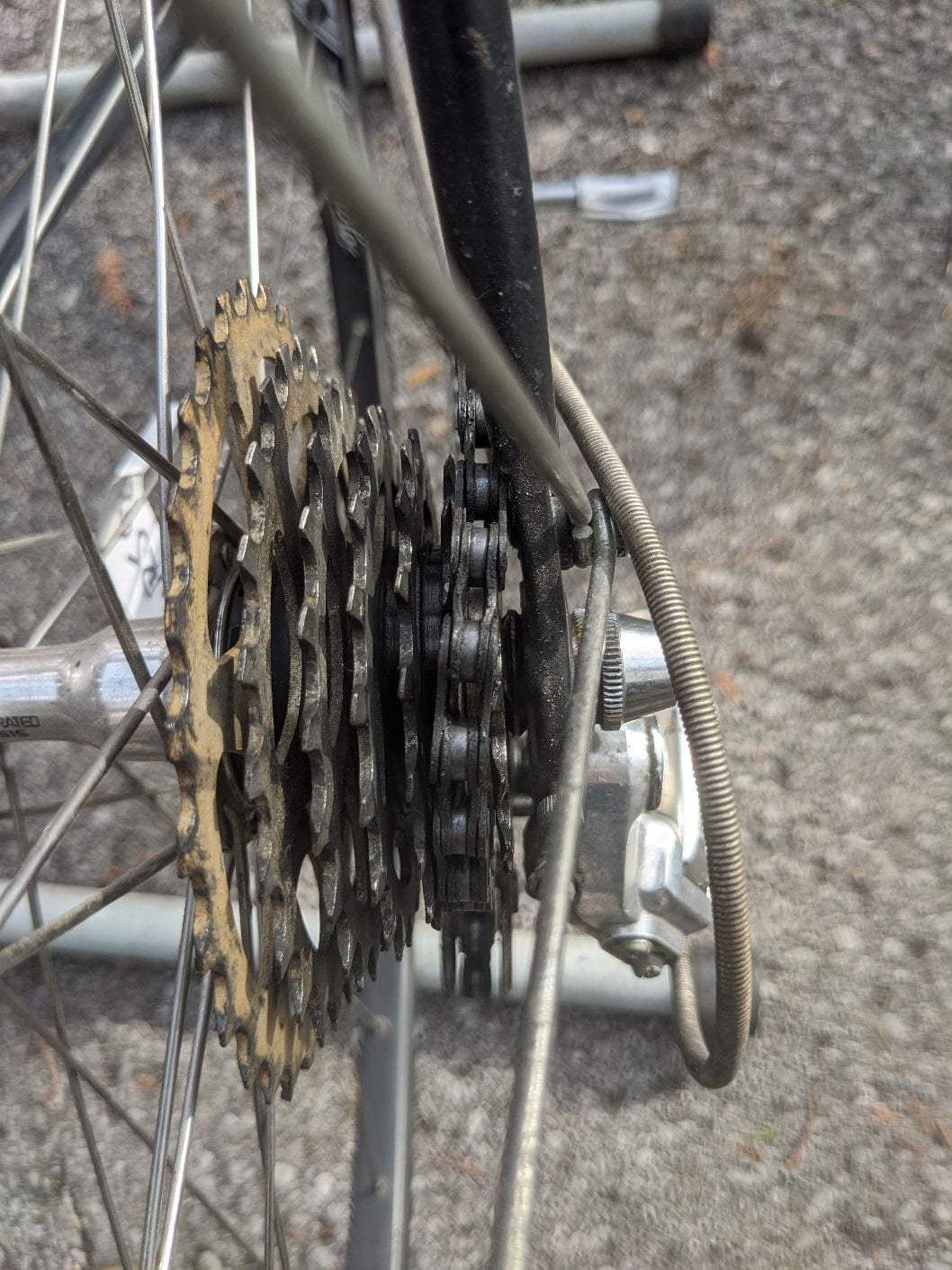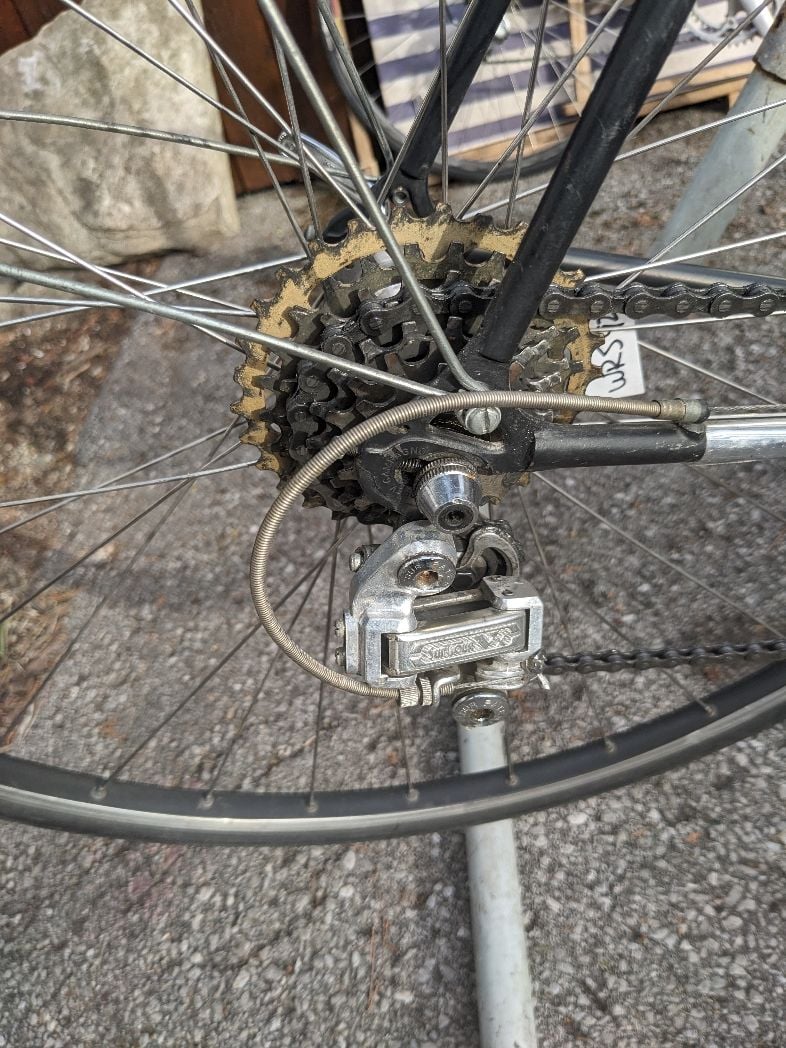fitting a 7S Uniglide wheel (freehub play, etc.)
#1
Senior Member
Thread Starter
Join Date: May 2008
Location: Toronto, Canada
Posts: 895
Bikes: (shortlist) Cyclops, Marinoni, Mariposa, Air Firday, Pocket Rocket Pro, NWT, SLX Fuso, Claude Pottie (France) x3, Masi Team 3v, Lemond Zurich, Bianchi OS
Mentioned: 2 Post(s)
Tagged: 0 Thread(s)
Quoted: 168 Post(s)
Liked 34 Times
in
27 Posts
fitting a 7S Uniglide wheel (freehub play, etc.)
a bit of a mulitpart question.
I was trying to install and test (to see if a Suntour Vx RD could actually handle a 30T sprocket) that 7S Uniglide 14-30T cassette today.
in High gear the chain jammed against the seatstay when shifting to #2 smallest.
and in Low gear the derailleur was just barely missing the spokes (it was nicking one but I could back that off just enough)
then I remembered that to install the cassette without play I had used a spacer to the inside of the Biggest cog.
That had probably left everything to far out to the outside to shifter correctly.
So, I removed the spacer (shifting everything a bit to the inside) and found that in fact all the sprockets tightened up nicely.
However the freehub body itself had play in it.
Jiggling my various other freehub wheels they all seemed to range from no play to a little bit of play (but all less play that this freehub)
1. how much freehub play is normal or too much? some is normal? How would I eliminate play?
2. but reinstalling the wheel without the spacer, i could now smoothly shift from #1 to #2 but now in order to shift into the biggest sprocket the derailleur caught the spokes.
how would I deal with this?
redish the wheel slightly?
or is there just a mismatch between wheel, frame, derailleur, cassette....?





I was trying to install and test (to see if a Suntour Vx RD could actually handle a 30T sprocket) that 7S Uniglide 14-30T cassette today.
in High gear the chain jammed against the seatstay when shifting to #2 smallest.
and in Low gear the derailleur was just barely missing the spokes (it was nicking one but I could back that off just enough)
then I remembered that to install the cassette without play I had used a spacer to the inside of the Biggest cog.
That had probably left everything to far out to the outside to shifter correctly.
So, I removed the spacer (shifting everything a bit to the inside) and found that in fact all the sprockets tightened up nicely.
However the freehub body itself had play in it.
Jiggling my various other freehub wheels they all seemed to range from no play to a little bit of play (but all less play that this freehub)
1. how much freehub play is normal or too much? some is normal? How would I eliminate play?
2. but reinstalling the wheel without the spacer, i could now smoothly shift from #1 to #2 but now in order to shift into the biggest sprocket the derailleur caught the spokes.
how would I deal with this?
redish the wheel slightly?
or is there just a mismatch between wheel, frame, derailleur, cassette....?





#2
Senior Member
Join Date: Apr 2016
Posts: 1,248
Mentioned: 3 Post(s)
Tagged: 0 Thread(s)
Quoted: 505 Post(s)
Liked 437 Times
in
336 Posts
2. but reinstalling the wheel without the spacer, i could now smoothly shift from #1 to #2 but now in order to shift into the biggest sprocket the derailleur caught the spokes.
how would I deal with this?
redish the wheel slightly?
or is there just a mismatch between wheel, frame, derailleur, cassette....?
how would I deal with this?
redish the wheel slightly?
or is there just a mismatch between wheel, frame, derailleur, cassette....?
#3
Senior Member
a bit of a mulitpart question.
I was trying to install and test (to see if a Suntour Vx RD could actually handle a 30T sprocket) that 7S Uniglide 14-30T cassette today.
in High gear the chain jammed against the seatstay when shifting to #2 smallest.
and in Low gear the derailleur was just barely missing the spokes (it was nicking one but I could back that off just enough)
then I remembered that to install the cassette without play I had used a spacer to the inside of the Biggest cog.
That had probably left everything to far out to the outside to shifter correctly.
So, I removed the spacer (shifting everything a bit to the inside) and found that in fact all the sprockets tightened up nicely.
However the freehub body itself had play in it.
Jiggling my various other freehub wheels they all seemed to range from no play to a little bit of play (but all less play that this freehub)
1. how much freehub play is normal or too much? some is normal? How would I eliminate play?
2. but reinstalling the wheel without the spacer, i could now smoothly shift from #1 to #2 but now in order to shift into the biggest sprocket the derailleur caught the spokes.
how would I deal with this?
redish the wheel slightly?
or is there just a mismatch between wheel, frame, derailleur, cassette....?


I was trying to install and test (to see if a Suntour Vx RD could actually handle a 30T sprocket) that 7S Uniglide 14-30T cassette today.
in High gear the chain jammed against the seatstay when shifting to #2 smallest.
and in Low gear the derailleur was just barely missing the spokes (it was nicking one but I could back that off just enough)
then I remembered that to install the cassette without play I had used a spacer to the inside of the Biggest cog.
That had probably left everything to far out to the outside to shifter correctly.
So, I removed the spacer (shifting everything a bit to the inside) and found that in fact all the sprockets tightened up nicely.
However the freehub body itself had play in it.
Jiggling my various other freehub wheels they all seemed to range from no play to a little bit of play (but all less play that this freehub)
1. how much freehub play is normal or too much? some is normal? How would I eliminate play?
2. but reinstalling the wheel without the spacer, i could now smoothly shift from #1 to #2 but now in order to shift into the biggest sprocket the derailleur caught the spokes.
how would I deal with this?
redish the wheel slightly?
or is there just a mismatch between wheel, frame, derailleur, cassette....?


As mentioned, verify that the hanger is OK, and that the RD's pivots aren't too worn causing the pulley cage to be sloppy and tilted inwards.
For the freehub, it could possibly be that body's bearings is worn or not properly adjusted. Shimano freehub bodies usually has spacers/washers within, that adjust the preload. You would need a tool to remove the bearing cup to access the spacers (and the 50 tiny ball bearings)
It's also possible that the freehub body isn't torqued onto the hub shell properly. Of course, the DA takes a special tool for that.
#4
Senior Member
Join Date: Feb 2012
Location: Rochester, NY
Posts: 18,100
Bikes: Stewart S&S coupled sport tourer, Stewart Sunday light, Stewart Commuting, Stewart Touring, Co Motion Tandem, Stewart 3-Spd, Stewart Track, Fuji Finest, Mongoose Tomac ATB, GT Bravado ATB, JCP Folder, Stewart 650B ATB
Mentioned: 0 Post(s)
Tagged: 0 Thread(s)
Quoted: 4212 Post(s)
Liked 3,883 Times
in
2,318 Posts
The SunTour V series ders weren't designed with the guide pulley center to most inward surface of the cage (or pulley bolt end) that works nicely with the closer large cog to spoke dimension that the early Shimano cassettes used. Really close inner cage to spoke clearance (if at all) can be a really bad thing when that clearance changes... I suggest being very careful in this aspect.
One thing not mentioned (if I read correctly) is that the second photo showing the spaced behind the cassette also, by my eyes, seem to show the smallest cog is too close to the second smallest cog. These twist tooth cassettes usually have a thin (about 1mm) spacer (that is scalloped to avoid the ends of the tiny bolts that keep the rest of the cassette cogs together) between the small and second small cog. The goal is to have the same cog C-C dimension across all the cogs. This might explain the small cog shifting issues.
Generally the cup and cone freehub bodies (read as Shimano) have similar bearing play like freewheels do. Of course this play has a range and can wear... Andy
One thing not mentioned (if I read correctly) is that the second photo showing the spaced behind the cassette also, by my eyes, seem to show the smallest cog is too close to the second smallest cog. These twist tooth cassettes usually have a thin (about 1mm) spacer (that is scalloped to avoid the ends of the tiny bolts that keep the rest of the cassette cogs together) between the small and second small cog. The goal is to have the same cog C-C dimension across all the cogs. This might explain the small cog shifting issues.
Generally the cup and cone freehub bodies (read as Shimano) have similar bearing play like freewheels do. Of course this play has a range and can wear... Andy
__________________
AndrewRStewart
AndrewRStewart
#5
Senior Member
The SunTour V series ders weren't designed with the guide pulley center to most inward surface of the cage (or pulley bolt end) that works nicely with the closer large cog to spoke dimension that the early Shimano cassettes used. Really close inner cage to spoke clearance (if at all) can be a really bad thing when that clearance changes... I suggest being very careful in this aspect.
One thing not mentioned (if I read correctly) is that the second photo showing the spaced behind the cassette also, by my eyes, seem to show the smallest cog is too close to the second smallest cog. These twist tooth cassettes usually have a thin (about 1mm) spacer (that is scalloped to avoid the ends of the tiny bolts that keep the rest of the cassette cogs together) between the small and second small cog. The goal is to have the same cog C-C dimension across all the cogs. This might explain the small cog shifting issues.
Generally the cup and cone freehub bodies (read as Shimano) have similar bearing play like freewheels do. Of course this play has a range and can wear... Andy
One thing not mentioned (if I read correctly) is that the second photo showing the spaced behind the cassette also, by my eyes, seem to show the smallest cog is too close to the second smallest cog. These twist tooth cassettes usually have a thin (about 1mm) spacer (that is scalloped to avoid the ends of the tiny bolts that keep the rest of the cassette cogs together) between the small and second small cog. The goal is to have the same cog C-C dimension across all the cogs. This might explain the small cog shifting issues.
Generally the cup and cone freehub bodies (read as Shimano) have similar bearing play like freewheels do. Of course this play has a range and can wear... Andy





